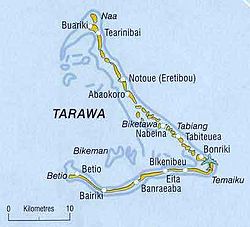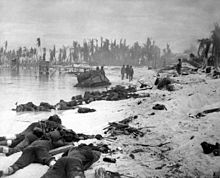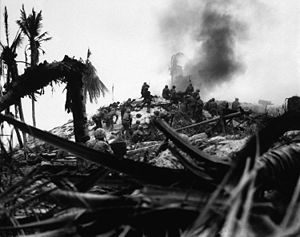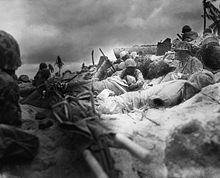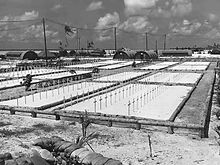Victory Despite the Screw-ups
Tarawa Atoll is a flyspeck in the Pacific Ocean and is made up of fifteen small islands, about 2400 miles SW of Pearl Harbor.
On November 20-23, 1943 it became the bowels of hell.
Approximately two miles long and 800 yards wide at its widest point, it is a skinny triangle of coral topped with enough soil to be home to a few palm trees and scrubby brush. The islands almost encircle a large lagoon.
The Japanese had been its landlord since 1941 and had spent almost a year fortifying the island. Over 500 pillboxes dotted the island. A series of eight-inch coastal defense guns guarded open water approaches.
Forty artillery pieces were scattered around the island. Due to the small size and flat topography, every beach on the island could be hit. At the top of those beaches, were walls of palm logs five feet high, hiding rifle pits, machine gun nests and anti-tank guns.
The Japanese had changed their anti-assault battle plans from one of allowing the enemy to come ashore and just when he thought the attack was going to be a cakewalk, rain fire on him from all directions. The High Command took a page from Rommel’s book and decided a stop-them-in-the-water tactic would be best.
The Japanese Commanding General, Rear Admiral Keiji Shibazaki was so pleased with his preparations, he chortled, “It would take one million men one hundred years “ to take Tarawa.
Major General Holland “Howlin’ Mad” Smith, Fifth Amphibious Corps, USMC didn’t think so. Nor did Major General Julian Smith, 2nd Marine Division, USMC.
The Americans had prepared extensively for the fight as well, but did so from a position of ignorance.
Tarawa was not on anyone’s travel brochure. Even maps of the island, originally owned by the British but now in Japanese hands, were over 100 years old. There were no records of tides and currents in the surrounding waters. Reefs sheltered many parts of the atoll.
Both sides focused on Betio, a flat little island in the SW corner of the atoll. It is the largest island and guards the only entrance to the lagoon. Having built their main airfield there, the Japanese concentrated their forces there and is where the Marines focused their effort.
As the invasion force closed in, it received fire from the coastal guns. Counter-fire from the battleships Colorado and Maryland silenced most of the fire and hit one of the coastal guns ammunition storage. The door to the lagoon was open.
The Americans used AMTRACs – armored amphibious tractors — to make the landings.
The 2nd Marines would lead the assault. They thought it was going to be a piece of cake. Wrong.
Things started going downhill fast. Strong currents made loading Marines on landing craft chaotic. Vibration from the Maryland’s firing took out the communications, disrupting coordination between naval and air attacks. The covering bombardment from the Navy’s ships stopped too early. Many of the Marines were still in the landing craft approaching the beaches.
The reefs surrounded the beaches 800-1000 yards out. The water was too shallow for the AMTRACs and most of them got stuck on the reefs. The troops had to disembark and wade to shore holding their weapons above their head. The Japanese recovered from the ships shelling and began shooting at the sitting ducks wading towards them. Enemy artillery threw round after round at the men in the lagoon. Marines were being killed in droves.
Navy air strikes began to make a dent in the Japanese artillery and some Marines were making it to shore and poured fire on the defenders, allowing more attackers to make it to shore. A round from a battleship hit the main Japanese ammo dump on the nearby island of Bairiki and cut off the enemy’s escape route.
At a great cost, the Marines, slowly and painfully, were making progress. Tanks landed and began taking out enemy machine guns. Flame-throwers took out rifle positions and cleared bunkers. Americans were breaking out of the beachheads and making progress all across the island.
Finally, most of the Japanese were jammed in the eastern part of the island and fight to the last man. Marines began to hit them from all sides. They had scores to settle. By late November the island was secured.
The price of victory is never cheap and Tarawa was not just an expensive win for the Marines, it was extravagant. Over 1000 KIA and 2100 wounded. The enemy lost almost 5000 KIA.
Marine valor and heroism wasn’t just commonplace, it was the order of the day. Semper Fi!

